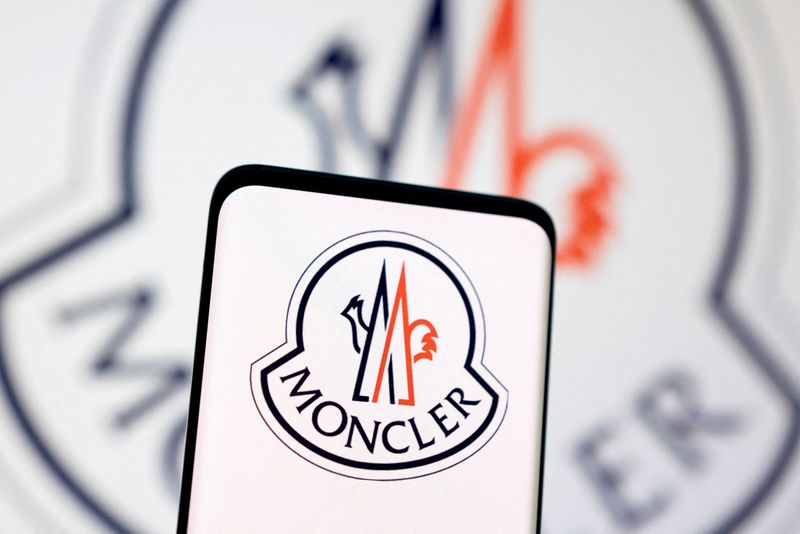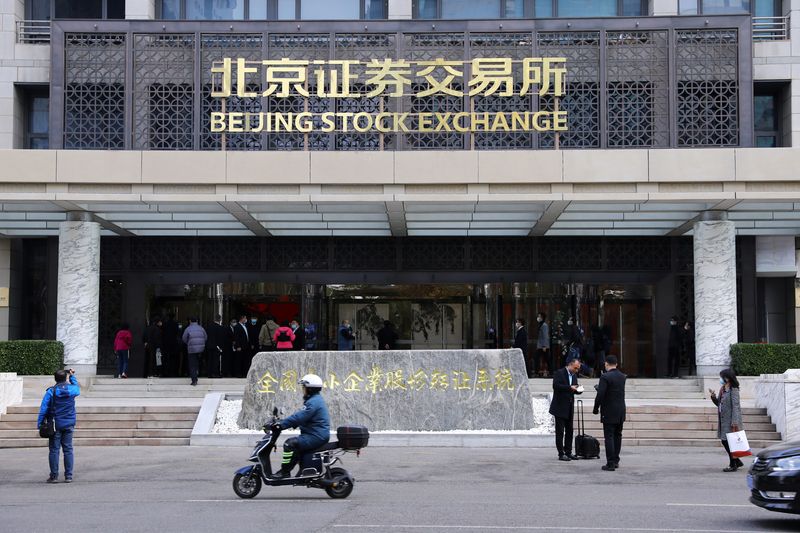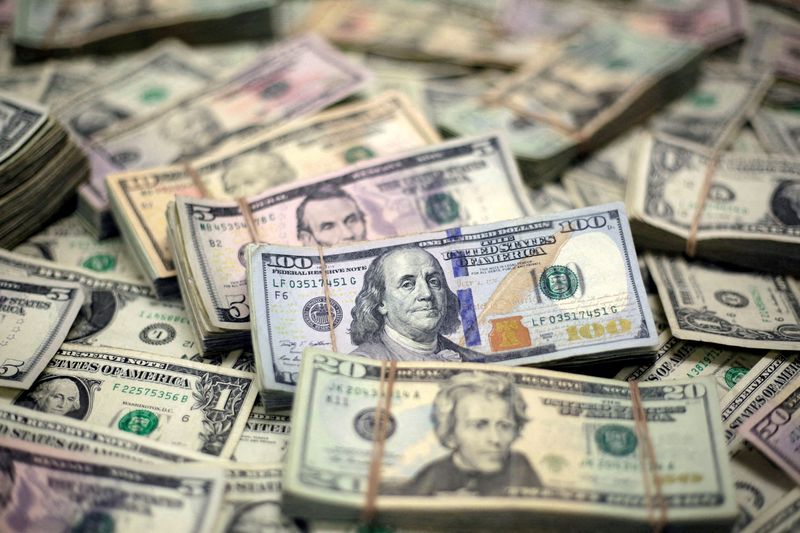Select Language

BUENOS AIRES (Reuters) -Argentina's poverty rate soared to almost 53% in the first half of the year, official data released on Thursday showed, the first hard evidence of the painful impact of libertarian President Javier Milei's tough austerity measures.
That marked a steep jump from 41.7% at the end of last year and more than double the 26% just seven years ago, underscoring the severe cost to regular Argentines of repeated economic crises that have hammered the South American nation.
The data underscores how Milei's spending cuts, aimed at overturning a deep fiscal deficit, have caused major short-term pain. The country is in a deep recession and inflation remains in triple digits, though there are signs things are improving.
"Since this government came to power, jobs have dropped away," said Irma Casal, a 53-year-old in Buenos Aires, who works three shifts as a garbage recycler, cardboard collector and bricklayer, but still struggles to stay afloat.
"We work twice as hard for less and we have to keep going."
Agustin Salvia, director of the UCA's Observatory, said that there was a significant impact at the start of the year from Milei's policies. However, there had been signs of an improvement recently, he added.
"If you look at the whole story, it shows a deterioration in the first quarter. That situation has since started to ease," he said.
Argentina's government has cut some welfare programs and reduced support to soup kitchens, but argues that it has also expanded two key welfare programs, the Universal Child Allowance and a Food Card program, giving direct support to families.
"Any level of poverty is horrendous," presidential spokesman Manuel Adorni said in a daily press conference on Thursday, blaming mismanagement by previous governments for leaving economic "bombs" that Milei was now trying to deactivate.
"We are doing everything, everything so that this situation changes."
Milei's spending cuts have been cheered by markets and investors for helping right the state's finances after years of deficits, but have pushed the country into a recession, despite signs the economy could now be bottoming out.
The Catholic University of Argentina's (UCA) observatory had estimated the poverty rate soared to 55.5% in the first quarter of the year before easing to 49.4% in the second quarter, giving a 52% average for the first six months of this year.
'ANY LEVEL OF POVERTY IS HORRENDOUS'

By Elisa Anzolin and Mimosa Spencer
MILAN/PARIS (Reuters) -Moncler's Chairman and CEO Remo Ruffini is tightening his control of the outerwear specialist after striking a deal with LVMH, which will partner with Ruffini to fund an expanded investment in the Italian company.
The deal also strengthens French group LVMH's dominance of the global luxury sector. Milan-based Moncler, one of the industry's biggest success stories in recent years, had been seen as a potential acquisition target or merger candidate for rival luxury groups seeking to expand.
Under the deal announced late on Thursday, LVMH purchased a 10% stake in Double R, the investment vehicle controlled by the CEO's Ruffini Partecipazioni Holding, which currently has a 15.8% stake in Moncler.
Double R will increase its stake in Moncler up to 18.5% over the next 18 months, thanks to the funding provided by LVMH that will increase its investment in Double R up to 22%, Ruffini Partecipazioni Holding and LVMH said in a statement.
Over the last nine months, two investors in Double R had exited the vehicle and were paid with Moncler shares, which had reduced Ruffini's control of the company.
The partnership with LVMH will reinforce Ruffini's position as the largest shareholder of Moncler, the companies said.
LVMH will gain the right to appoint two board members to Double R, solely controlled by Ruffini, as well as a director on Moncler's board.
Investors have grown jittery about a slowdown in the luxury sector, particularly weakness in the key Chinese market, hit by slowing economic growth and a property crisis.
But Moncler has proven resilient, with 11% revenue growth in the first half of the year, thanks to double-digit growth in Asia.

By Jamie McGeever
(Reuters) - A look at the day ahead in Asian markets.
Will this week be Chinese President Xi Jinping's equivalent of Mario Draghi's famous "whatever it takes" moment?
Only time will tell if China's volley of monetary, liquidity and fiscal stimulus shots this week sparks a sustainable economic recovery, but the rally ripping through Chinese stocks suggests investors are willing to give Beijing the benefit of the doubt.
At the very least, downside risks to growth and inflation have been pared back. Remove the near-term pessimism, and the outlook is suddenly a lot brighter, regardless of the underlying fundamental and structural challenges China's economy faces.
Couple that with a U.S. economy still seemingly on track for a 'soft landing' and a central bank determined to get ahead of the curve to deliver that outcome, the global picture is a lot brighter too.
Risk assets around the world are responding accordingly. The MSCI World and S&P 500 both hit new highs on Thursday.
In Asia, Shanghai's blue chip equity index is up 10.8% so far this week, which would be its biggest weekly rise since December, 2014. The broader Shanghai composite index is up 9.7%. A close at that level on Friday would mark its best week since November, 2008.
Hong Kong's benchmark Hang Seng index's 4% rally on Thursday brings its weekly gains to 9%, the most in 13 years. An index of mainland Chinese property stocks, meanwhile, leapt 16%.
The main potential brake on this momentum on Friday will be a wave of profit-taking ahead of the weekend, especially as it is coming up to the end of the quarter, and Chinese markets will be closed Oct. 1-7 for the Golden Week holiday.
While the euphoria and relief are understandable given how beaten down sentiment and asset prices were, a sense of caution is warranted.
Although Draghi's "whatever it takes" commitment in 2012 to save the euro greatly reduced the risk of financial and political catastrophe - bond yield spreads have been lower ever since - the actual policies behind it didn't fundamentally solve the euro zone's severe economic problems.
Similarly, Beijing's measures this week won't fully solve China's property bust, banish the threat of deflation, or address its long-term demographic challenges.
But that's for another day. Or year.
The main Asian economic indicator on deck on Friday is Tokyo consumer price inflation for September, which is expected to show a fairly sharp slowdown in the annual core rate to 2.0% from 2.4%.
Minutes from the Bank of Japan's July meeting on Thursday showed that policymakers were divided on how quickly interest rates should be raised again, highlighting uncertainty on the timing of the next increase in borrowing costs.
Here are key developments that could provide more direction to Asian markets on Friday:
- Tokyo inflation (September)
- Japan leading indicators (July)
- German unemployment (September)

Investing.com -- Wells Fargo now forecasts that China's economy will grow 4.6% in 2024, a downgrade from the earlier estimate of 4.8% and below the government's official 5% target.
The bank’s economists believe that despite recent policy support from Chinese authorities, these measures are not sufficient to address the deeper structural challenges faced by the economy. They highlight that China’s growth remains hampered by a subdued property market, weak domestic consumption, and deflationary pressures, with consumer confidence remaining low.
Chinese policymakers have introduced several measures aimed at shoring up the property sector and stimulating growth, including lowering lending rates and reducing the reserve requirement ratio for major banks. Yet, according to Wells Fargo, these policies are unlikely to significantly change the economic trajectory.
“Directionally speaking, easier monetary policy and support for the property sector is an appropriate course of action; however, we believe the recent announcements are not a cure for China's growth challenges,” economists said in a note.
“As far as property sector support, we believe Chinese consumers are unwilling to direct capital toward real estate at the current juncture, given the sharp and ongoing downturn in the industry,” they added.
Further complicating the economic outlook is China’s monetary policy. Wells Fargo points out that the People’s Bank of China (PBOC) has been in easing mode for some time, but these actions have not been able to ignite economic activity.
Specifically, real interest rates in China remain positive and restrictive. Economists said the "gradual easing of monetary policy that maintains restrictive monetary policy settings will continue to act as a drag on China's economy for the time being.”
In terms of fiscal policy, Wells Fargo notes the limited role it has played in recent years. While China deployed substantial fiscal stimulus in past crises, such as during the Global Financial Crisis, fiscal support has been relatively absent in the post-COVID era.
The report suggests that Chinese authorities may be hesitant to increase fiscal stimulus due to the country's high debt burden and concerns that households would opt to save rather than spend any stimulus, particularly in the current deflationary environment.
Looking ahead, Wells Fargo expects China’s economic growth to slow further in 2025, forecasting a modest 4.3% growth rate.

By Ankur Banerjee and Laura Matthews
SINGAPORE/NEW YORK (Reuters) - As the market euphoria to China's biggest stimulus since the pandemic settles, foreign investors are now asking whether the $114 billion toolkit will provide the spark needed to turn around a beat-up stock market.
Chinese equities have lagged major markets all year, despite a series of piecemeal measures authorities have rolled out to revive the anemic economy and lift stock prices.
This week's measures were sweeping. The package of rate cuts and, importantly for markets, an 800 billion yuan ($114 billion) facility to fund stock purchases showed Beijing's new urgency to cure the world's second-biggest economy of deflation and a distressed property market.
Chinese stocks soared, with the blue chip index CSI300 wiping out its losses for the year and set for strongest weekly performance since 2022. The yuan rose to a 16-month high against the U.S. dollar.
On Thursday, China's leaders pledged to support the struggling economy through "forceful" interest rate cuts and adjustments to fiscal and monetary policies, adding more fuel to the rally.
Investors said that reaction showed how depressed sentiment was but the measures didn't fix what most overseas investors want to see fixed: fiscal measures that directly spur consumer demand.
The package was mostly about "getting liquidity into the markets, but we're at a point in which more liquidity alone isn't going to deliver the sustained recovery long-term investors want to see," said Phillip Wool, head of portfolio management at Rayliant Global Advisors.
"As long as demand remains as weak as it has been, nobody's going to want to borrow, and measures like these won't have the desired impact," Wool said.
Chinese stocks have stuttered in recent years even as markets elsewhere scaled record peaks, leading investors to pull out and stay away, with over a quarter of global funds tracked by Copley Fund Research not holding any exposure to China at all. Almost all funds kept China exposure in 2021.
While the CSI300 index and Hong Kong's Hang Seng have surged in the past two days, they remain down 40% from February 2021 peaks. In comparison, Japan's Nikkei is up 24% and the S&P 500 has risen 45% in the same period.
For Gary Tan, portfolio manager at Allspring Global Investments, this week's measures are unlikely to lead him to shift his underweight position on China.
"We think it will take a fundamental change in China’s deflation outlook and the China property market for investors to commit new funds into China," Tan said.
Vivian Lin Thurston, portfolio manager for William Blair’s emerging markets growth strategy, is currently underweight China and mostly unswayed by the new measures.
However, Thurston said her fund could potentially add to certain stocks that show improved fundamentals and are less impacted by the economic backdrop.
CHEAP STOCKS
The success of some of these measures, including ones aimed at capital markets, will depend on whether institutional investors feel comfortable to come back into equities.
China risks missing this year's economic growth target of roughly 5% due to property downturn and frail consumption, which analysts say can only be fixed by fiscal policies that put money into consumers' pockets.
"Meaningful and effective fiscal stimulus needs to come through in order to address these key economy challenges effectively," said William Blair's Thurston.
To be sure, some investors, such as Jonathan Pines, head of Asia ex-Japan at Federated Hermes (NYSE:FHI), and Rayliant's Wool are attracted by the valuations.
The Shanghai benchmark index trades at price-to-earnings ratio, a commonly used valuation metric, of 12, while the Nikkei trades at 21 and the S&P 500 at 27.
In particular, Bob Zhang, managing partner of Beijing-based Pine Street Capital, likes stocks that focus on AI computing power, semiconductors and software as a service, which he sees as cheap and benefit from global technology developments.
Investors also point to the fact that China is pulling out the stops at the same time that the U.S. Federal Reserve has started cutting rates.
"If the United States continues to cut interest rates as expected, and China continues its policy easing, I believe the market will form positive feedback and continue to rise," said Pine Street Capital's Zhang.
($1 = 7.0165 Chinese yuan)

By Khanh Vu and Francesco Guarascio
HANOI (Reuters) -Elon Musk's SpaceX plans to invest $15 billion in Vietnam in the near future, the government of the Communist-run nation said on Thursday, which could help resolve a stalemate over the launch of its Starlink satellite services there.
Months of talks on the offer of Starlink's satellite internet connection and other communications services were put on hold at the end of 2023, sources familiar with the matter had told Reuters earlier this year, although they resumed later.
"The Vietnamese government is considering the (investment) proposal of SpaceX," a report on the government portal on Thursday quoted President To Lam as saying, asking the company to work closely on completing preparations for the investment.
The remark followed the leader's meeting in New York with SpaceX government affairs official Tim Hughes, who said the company planned to invest $15 billion in Vietnam, a promising market for its satellite internet service, the report added.
The government did not clarify where SpaceX's investment would be made, nor when details could be agreed.
U.S.-based SpaceX did not immediately respond to a Reuters request for comment.
Vietnam's foreign ministry did not respond to a request for comment.
With 100 million people, Vietnam is a large user base for U.S. internet companies such as Meta's Facebook (NASDAQ:META) and Alphabet (NASDAQ:GOOGL), but its ageing equipment can disrupt operations of key optic fibre undersea cables.
Large mountainous swathes also make internet services less reliable in Vietnam, which could also use satellite internet for tasks such as tighter patrolling in the disputed South China Sea where it is often at odds with China.
By Khanh Vu and Francesco Guarascio
HANOI (Reuters) -Elon Musk's SpaceX plans to invest $15 billion in Vietnam in the near future, the government of the Communist-run nation said on Thursday, which could help resolve a stalemate over the launch of its Starlink satellite services there.
Months of talks on the offer of Starlink's satellite internet connection and other communications services were put on hold at the end of 2023, sources familiar with the matter had told Reuters earlier this year, although they resumed later.
"The Vietnamese government is considering the (investment) proposal of SpaceX," a report on the government portal on Thursday quoted President To Lam as saying, asking the company to work closely on completing preparations for the investment.
The remark followed the leader's meeting in New York with SpaceX government affairs official Tim Hughes, who said the company planned to invest $15 billion in Vietnam, a promising market for its satellite internet service, the report added.
The government did not clarify where SpaceX's investment would be made, nor when details could be agreed.
U.S.-based SpaceX did not immediately respond to a Reuters request for comment.
Vietnam's foreign ministry did not respond to a request for comment.
With 100 million people, Vietnam is a large user base for U.S. internet companies such as Meta's Facebook (NASDAQ:META) and Alphabet (NASDAQ:GOOGL), but its ageing equipment can disrupt operations of key optic fibre undersea cables.
Large mountainous swathes also make internet services less reliable in Vietnam, which could also use satellite internet for tasks such as tighter patrolling in the disputed South China Sea where it is often at odds with China.
Such a step may not go down well with Beijing, however.
INVESTING WHERE?
Thursday's news follows a report this month on the government portal that cited Hughes as saying SpaceX aimed to provide Starlink services to the Southeast Asian nation, after the two sides had resumed talks.
At the time, Hughes, the company's senior vice president for global business and government affairs, said SpaceX's deployment of internet services in Vietnam aimed mainly to benefit education and disaster prevention efforts, state media reported.
Last year's talks were stymied by questions about ownership of the company SpaceX would have to set up in Vietnam, which limits foreigners' holdings in such firms to half, while SpaceX wanted at least a controlling stake, sources had told Reuters.
It is unclear whether this issue is still a hurdle.
Vietnam also requires data to be stored domestically, with strict controls on what is visible online.
Industry sources told Reuters SpaceX has suppliers in Vietnam, a major industrial hub home to large manufacturing operations of U.S. firms and their contractors.
Apple (NASDAQ:AAPL), with dozens of suppliers in the country, said in April it wanted to invest more by increasing spending on them.

By Kevin Buckland
TOKYO (Reuters) - The dollar held firm on Thursday following its sharpest rally since early June as traders looked ahead to speeches from key Federal Reserve policy makers later in the day for clues on the pace of interest rate cuts.
The U.S. currency rebounded strongly overnight from a more than one-year low to the euro and 2 1/2-year trough versus sterling.
While there was no obvious catalyst for the rebound, investors appeared to take a more nuanced view on just how aggressive future U.S. rate reductions would be, with Fed speakers this week not presenting a unified view on the path forward.
On Wednesday, Fed Governor Adriana Kugler said she "strongly supported" the decision to cut rates by half a point earlier this month to kick off the easing cycle, but didn't talk about her preferences for the pace of reductions from here.
Earlier this week, Chicago Fed President Austan Goolsbee said policymakers "can't be behind the curve" if the economy is to have a soft landing. Atlanta Fed President Raphael Bostic said the central bank needn't go on a "mad dash" to lower rates.
"I'm not getting the feeling at this point that it's particularly unanimous," said Kenneth Crompton, chief rates strategist at National Australia Bank (OTC:NABZY).
"It sort of feels like they've done their catch up...and from here it's probably more 25s than 50s."
Later Thursday, Fed Chair Jerome Powell gives pre-recorded remarks at a conference in New York, where New York Fed President John Williams also speaks. Boston Fed President Susan Collins and Fed Governors Michelle Bowman and Lisa Cook take to the podium at various other venues as well.

By Nandita Bose and Gabriella Borter
PITTSBURGH, Pa. (Reuters) -U.S. Vice President Kamala Harris said on Wednesday she would offer tax credits to domestic manufacturers and invest in sectors that will "define the next century", as she detailed her economic plan to boost the U.S. middle class.
Speaking at the Economic Club of Pittsburgh in the battleground state of Pennsylvania, the Democratic candidate in the Nov. 5 presidential election said she would give tax credits to U.S. manufacturers for retooling or rebuilding existing factories and expanding "good union jobs," and double the number of registered apprenticeships during her first term.
Harris also promised new investments in industries like bio-manufacturing, aerospace, artificial intelligence and clean energy.
Harris' speech, which lasted just under 40 minutes, did not detail how these policies would work. She highlighted her upbringing by a single mother, in contrast with Trump, the wealthy son of a New York real estate developer.
"I have pledged that building a strong middle class will be the defining goal of my presidency," Harris said, adding that she sees the election as a moment of choice between two "fundamentally different" visions of the U.S. economy held by her and her Republican opponent Donald Trump.
The vice president and Trump are focusing their campaign messaging on the economy, which Reuters/Ipsos polling shows is voters' top concern, as the election approaches.
The divide between rich and poor has grown in recent decades. The share of American households in the middle class, defined as those with two-thirds to double that of median household income, has dropped from around 62% in 1970 to 51% in 2023, Pew Research shows. These households' income has also not grown as fast as those in the top tier.
Trump, Harris said, is "only interested in making life better for himself and people like himself, the wealthiest of Americans."
She said she was committed to working with the private sector and entrepreneurs to help grow the middle class. She told the audience that she is "a capitalist" who believes in "free and fair markets," and described her policies as pragmatic rather than rooted in ideology.
Harris in recent months has blunted Trump's advantage on the economy, with a Reuters/Ipsos poll published on Tuesday showing the Republican candidate with a marginal advantage of 2 percentage points on "the economy, unemployment and jobs," down from an 11-point lead in late July.
Trump discussed his economic plan in North Carolina on Wednesday and said Harris' role as vice president gave her the chance now to improve the economic record of the Biden administration.
"Families are suffering now. So if she has a plan, she should stop grandstanding and do it," he said.While Trump has proposed across-the-board tariffs on foreign-made goods - a proposal backed by a slim majority of voters - Harris is focusing on providing incentives for businesses to keep their operations in the U.S.
Boosting American manufacturing in industries such as semiconductors and bringing back jobs that have moved overseas in recent decades have also been major goals for Biden. The Infrastructure Investment and Jobs Act, the CHIPS and Science Act, and the Inflation Reduction Act - all passed in 2021 and 2022 - fund a range of subsidies and tax incentives that encourage companies to place projects in disadvantaged regions.

PARIS (Reuters) - It is not realistic for France to lower its deficit to 3% of GDP within three years but it could be possible within five years with the right course of action, Bank of France head Francois Villeroy de Galhau on Wednesday.
"Three years is not realistic, not economically or with regards to growth. But to do it in five years is possible," Villeroy, who is also a policymaker at the European Central Bank, told France 2 TV.
Earlier this week, French finance minister Antoine Armand said the country's budget deficit was one of its worst in history. The government currently expects a 2024 budget deficit of 5.1% of GDP - above the European Union's limit of 3%.
Prime Minister Michel Barnier has suggested he would be open to raising taxes on the wealthy and some corporations as the country struggles to contain the deficit. Spending cuts are also expected, which Villeroy said in the interview that he supported.
One of the first hurdles for France's new government will be steering a budget for 2025 through an unruly hung parliament.

BANGKOK (Reuters) - Thailand's government on Wednesday launched the first phase of its flagship $14 billion stimulus handout scheme, which will eventually see an estimated 45 million people receive 10,000 baht each, saying it would spark economic activity.
The initial phase will see 10,000 baht distributed in cash to 14.5 million welfare card holders and disabled people, and is expected to be complete by the end of the month.
"Cash will be put into the hands of Thais and create a tornado of spending," Prime Minister Paetongtarn Shinawatra said at an event to mark the programme's start.
The "digital wallet" scheme was initially structured to distribute the funds through a smartphone app, with the money to be spent in local communities within six months.
"There will be more stimulus measures and we will move forward with the digital wallet policy," said Paetongtarn.
The scheme has been criticised by economists, including two former central bank governors, as fiscally irresponsible. The government rejects that, but has struggled to find sources of funding.
Southeast Asia's second-largest economy is expected to grow 2.6% this year after an expansion of 1.9%, behind regional peers.
($1 = 32.61 baht)

